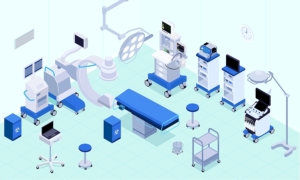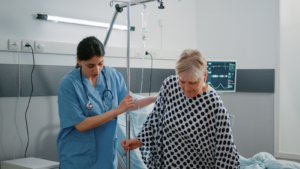Congress Newsletter 2022
The advance of machines for drug delivery – scary? Or just another team member?
Session 01ME3 – Machines for drug delivery: change will happen, resistance is futile
Today Monday, June 6, 0930-1030H, Amber Room
Today’s final morning of Euroanaesthesia 2022 sees the often-controversial topic of automation addressed by Professor Michel Struys of University Medical Center Groningen, Netherlands. He will address all of your concerns – both the open and hidden ones – and confront the biggest factor that is slowing the advance of automation – regulation.
When looking at the impact of any drug, whether it is administered intravenously, intranasally or orally, the concentrations of the drug in the blood plasma will rise, before it moves on to the ‘effect site’ and couples with receptors, causing the ‘clinical effect’. “Automation can be added to measure and control any of these steps – indeed, the technology already exists to do it, so what is holding us back? Two major things – regulation and trust in the technology from us the clinicians,” says Prof Struys.
“In fields such as fluid management and haemodynamic control, the medical world is almost ‘ready-to-go’,” he explains. “Medical experts will watch carefully as these technologies are approved and rolled out in hospitals worldwide. However, a never-ending list of regulatory hurdles is preventing the commercialisation of automated closed-loop drug delivery in total intravenous anaesthesia. But many of us believe that automation should be taking its rightful place as just another member of the medical team ensuring the best possible outcome for patients.”
The requirements of the US Food and Drug Administration (FDA) and the European Medicines Agency (through its Medical Device Regulations) are making the cost-benefit analysis for the progression of this technology in, for example, closed-loop anaesthesia, currently impossible. “There are also issues linked specifically to anaesthesia, such as how to better link (processed) electroencephalographic readings with the cerebral drug effects,” explains Prof Struys. “As technology and science advances, better algorithms will be developed and confidence in the technology will increase.”
Prof Struys believes that once medical teams see automated technology successfully manage fluid management and haemodynamic control, they will be much more willing to incorporate automation in many (most) of the procedures connected with anaesthesia and analgesia. In terms of commercial profitability, some closed loop systems such as those used in diabetes are already on the market and profitable due to high demand from the huge and growing population with diabetes demanding such technology. But for now, closed-loop anaesthesia drug delivery remains just out of reach, even as we know that in other areas of life – for example, the autopilots used in commercial aviation – acceptance and appreciation of this technology happened long ago.
Prof Struys will also discuss that another possible outcome as this technology develops is a ‘hybrid’ system in which the physician gets final approval of any solution suggested by automated drug delivery. “Imagine a situation for example where a patient develops severe hypotension – the closed loop anaesthesia technology will suggest a solution and prepare an intervention – but this will effectively be advice, and the doctor would have to approve or reject this advice and be ready to explain their decision afterwards.”
Please join Professor Struys for today’s session as he navigates the ethical, technological, and regulatory issues that swirl around the ever-advancing field of automation.
Read More of our special newsletter covering our congress.











